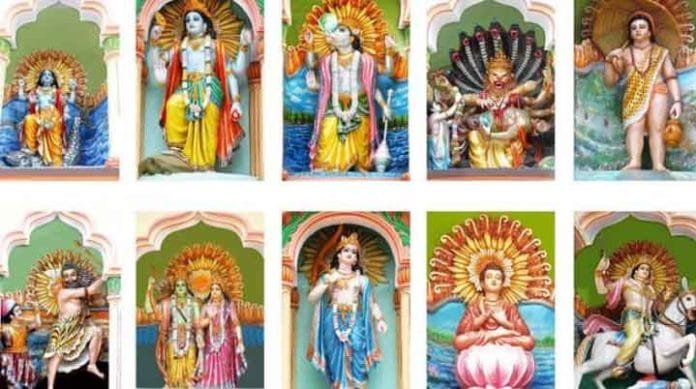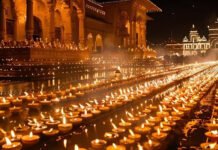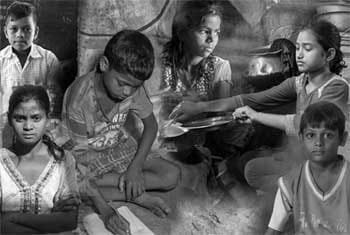Lord Vishnu, also revered as Shri Hari, is one of the principal deities in Hinduism. Known as the preserver of the universe, Vishnu has taken numerous forms to restore cosmic balance and protect the gods and devotees from various threats. Among his many incarnations are Vamana, Matsya, Kurma, and Narasimha. Each form carries a distinct significance and embodies unique aspects of divine intervention. One remarkable tale involves the Hayagriva avatar, which highlights Vishnu’s extraordinary measures to safeguard the celestial realms.
The Diverse Avatars of Lord Vishnu
Vamana: The Dwarf Brahmin
The Vamana avatar is a profound example of divine strategy and humility. Vishnu incarnated as a dwarf Brahmin to subdue the demon king Bali, who had gained control over the three worlds. By requesting three paces of land, Vamana demonstrated that true power lies not in physical might but in spiritual wisdom. As he expanded to cover the universe in three strides, Vamana reclaimed the heavens, earth, and netherworld, thus restoring the balance of cosmic order.
Matsya: The Great Fish
In the Matsya avatar, Vishnu took the form of a giant fish to rescue the sacred Vedas and the sage Manu from a catastrophic flood. This avatar symbolizes the protection and preservation of ancient wisdom, crucial for maintaining the principles of dharma. Matsya’s intervention ensured that knowledge and righteousness endured through the deluge, safeguarding the foundation of the universe.
Kurma: The Tortoise
The Kurma avatar, depicted as a colossal tortoise, played a pivotal role during the churning of the ocean (Samudra Manthan). As the gods and demons churned the ocean to obtain the nectar of immortality (amrita), Mount Mandara, used as the churning rod, began to sink. Vishnu, in the form of Kurma, supported the mountain on his back, enabling the successful extraction of amrita. This episode highlights the importance of divine assistance in achieving great endeavors.
Narasimha: The Man-Lion
The Narasimha avatar is one of the most dramatic and awe-inspiring forms of Vishnu. Manifesting as a half-man, half-lion, Narasimha was designed to circumvent the boon granted to the demon Hiranyakashipu, which made him nearly invincible. Narasimha emerged at dusk, a time that was neither day nor night, and killed Hiranyakashipu on a threshold, ensuring the conditions of the boon were met. This avatar underscores the triumph of good over evil and the divine protection extended to devotees.
The Hayagriva Avatar: A Tale of Divine Ingenuity
The Rise of the Demon Hayagriva
In the lesser-known yet significant Hayagriva avatar, Vishnu assumed a horse-headed form to defeat a demon of the same name. The demon Hayagriva had acquired immense power through penance and had received a boon that he could only be killed by a being with a horse’s head. Emboldened by this boon, Hayagriva unleashed terror upon the heavens, causing great distress among the gods.
Lord Vishnu’s Deep Sleep in Vaikuntha
During this period of turmoil, Lord Vishnu was in a state of profound sleep in Vaikuntha, his celestial abode, resting on a bow string. The desperate gods, seeking relief from Hayagriva’s tyranny, approached Lord Brahma for a solution. Brahma advised them to awaken Vishnu, but their efforts proved futile as Vishnu remained asleep.
The Intervention of Vamri
Brahma then directed an insect named Vamri to cut the bow string on which Vishnu was resting. As Vamri severed the string, it caused Vishnu’s head to be decapitated, plunging the universe into darkness and leaving the gods in a state of panic.
The Revelation by Goddess Bhagwati
In their despair, the gods prayed fervently to Goddess Bhagwati, who appeared before them and revealed that Vishnu’s decapitation was a preordained event necessary for defeating the demon Hayagriva. She explained that Hayagriva’s boon required a horse-headed being to slay him, and thus, Vishnu had to take this unique form.
The Transformation and Ultimate Victory
Lord Vishnu was then given the head of a horse, transforming into the mighty Hayagriva. In this form, he engaged the demon in a fierce battle and ultimately vanquished him, restoring peace and order to the heavens. This victory underscored Vishnu’s unyielding commitment to protecting the universe and upholding dharma.
The Symbolism and Legacy of Vishnu’s Avatars
Each avatar of Lord Vishnu carries profound symbolism and imparts valuable moral lessons. These incarnations illustrate the deity’s multifaceted approach to resolving cosmic conflicts and preserving the sanctity of the universe.
Key Lessons from the Avatars
- Vamana: Emphasizes humility and the spiritual superiority of wisdom over physical power.
- Matsya: Highlights the importance of preserving knowledge and righteousness.
- Kurma: Demonstrates the necessity of divine support in achieving monumental tasks.
- Narasimha: Reinforces the idea that good ultimately prevails over evil, regardless of the odds.
- Hayagriva: Shows the lengths to which divinity will go to restore balance and protect the righteous.
Relevance in Modern Times
These timeless tales continue to inspire and guide devotees, offering insights into the virtues of humility, perseverance, wisdom, and righteousness. They remind us of the divine protection available to those who uphold dharma and seek the higher truths of existence.
The Eternal Protector
Lord Vishnu, through his myriad forms, remains the eternal protector of the universe. His avatars, each unique and profound, reflect his unwavering dedication to maintaining cosmic harmony. The stories of Vamana, Matsya, Kurma, Narasimha, and Hayagriva enrich the spiritual heritage of Hinduism and provide enduring lessons for humanity. They invite us to reflect on the principles of righteousness and the ever-present divine support in our journey towards a just and harmonious life.
















